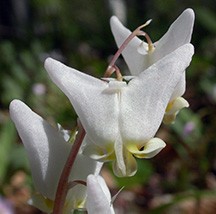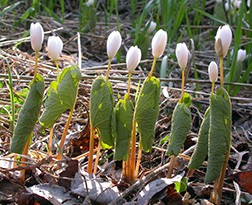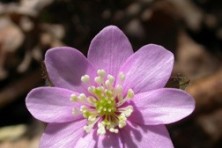Warm-up of Mayflowers
- Share
- Tweet
- Pin
- Share

One of the most star-like wildflowers in the spring woodlands is the Bloodroot. All photos by Roy Lukes
Can you imagine school children of this day and age not wanting to hike into a woodland to search for “white stars,” “red Indian paint” and especially genuine “green dragons?” In fact I’ve even motivated most of the intensely peer-oriented junior high students I’ve taught in past years into looking forward to our field excursions of learning in the vibrant tapestry of the “spring woods awakening.”
The “white stars’ and “red Indian paint” turned out to be Bloodroot flowers, Sanguinaria canadensis,” while the Green Dragon proved to be one of the most elusive wildflowers we’ve ever searched for. The delicate, oddly shaped Green Dragon, Arisaema dracontium, close relative of the Jack-In-The-Pulpit, most often grows in very moist bottomlands. We had good luck finding them in the damp woods next to the Wisconsin River south of Wisconsin Rapids when I taught in that city.
In fact it was in those woods that we had such great fun with the Bloodroot, one of the earliest wildflowers to emerge. First I would locate a large patch of several dozen Bloodroots, then dig down to secure a two- or three-inch root. Slicing through the root with a sharp jackknife caused it to ooze forth with very bloody-looking red-orange latex.
Demonstrating, I carefully and “artistically” decorated the face of one of the brave students. Next I provided each of the pupils with a short section of the brilliant root and told them to “Go to it!”
Now came the shocker. I gently informed them that it would take at least a week for the dye to wear off. What I didn’t tell them was that a little soap and water would easily remove the war paint. I did find out the next morning which kids washed their faces before coming to school.
These beautiful early blooming flowers, the Bloodroots, could appropriately be called white stars of the woodlands. Their pure white petals and gold centers make them very showy. Even though they can have four to 12 petals, the usual number is eight. Four of the eight petals are somewhat shorter and, alternating between the longer petals, provide some of the blossoms with a somewhat square appearance.
The fragile Bloodroot blossoms open in the morning facing upright, then gradually turn to a more vertical position toward evening and close during the night. A blossom will last several days. Cold or overcast days will find the flowers tightly closed and their large roundish leaves wrapped snugly around the stems like miniature overcoats.
If one were to travel to some of the off-the-beaten-track places out east and question the people there about this strikingly white flower in their woods, they might call it tetterwort, red puccoon, redroot, red Indian paint, corn root, turmeric, or sweet slumber, all tantalizing colloquialisms every bit as meaningful as our Bloodroot name.

Whoever was the first person to name this great favorite wildflower the Dutchman’s Breeches had a good imagination.
Their finger-thick, fleshy perennial rootstocks, aided by the large pancake-size leaves, slowly accumulate nourishment as the flowering season progresses. Come autumn the plant will have built up sufficient food in its root to enable the flower to emerge very early the following spring as the first hint of warmth and moisture are felt.
Other wildflowers including Irises, Solomon’s Seals, Trout Lilies, and Dutchman’s Breeches are also endowed with large root stocks, corms, or bulbs and will appear considerably earlier than those plants being more fibrous-rooted and delicate.
Those of you who are familiar with an old-fashioned garden favorite, Bleeding Hearts, will quickly see the similarity between the blossoms and leaves of this flower-garden perennial and the common woodland charmer, the Dutchman’s Breeches. Both belong to the Poppy Family, a group of delicate herbaceous plants known for their colored juice. Their genus name, Dicentra, (die-SEN-tra) is Greek for two-spurred. The “breeches” species name, cucullaria (kew-kew-LAY-ri-a), refers to a hood.
Run your hand lightly over a cluster of their soft, feathery, finely-cut foliage and you’ll soon realize how delicate and fragile it is. It stands to reason that one would seldom find these plants growing where they would be exposed to frequent strong winds. Their white flowers resemble the full trousers the Dutch men used to wear. The unusual blossoms are tinged with yellow at the “waistline.”
Observe a patch of these pantaloon-like flowers long enough and you will almost certainly see bumblebees land to inspect them. Mark my word, if you could measure the insect’s tongue it would be as long or longer than the nectaries (“pant legs”). Strong female Bumblebees are known for their long tongues.
Frequently you will see holes chewed into the sides of the blossoms, short cuts for getting at the nectar. Bumblebees most likely produced those holes having jagged edges. Wasps are known to make clean-cut, more circular openings while carpenter bees cut narrow slits through which they rob various deep blossoms of their nectar.
Many people confuse the Dutchman’s Breeches with its less common cousin, the Squirrel Corn, Dicentra canadensis. Squirrel Corn, named for its underground, pale yellow, roundish nut-like corms (which squirrels like) has rounded spurs on its white flowers that more closely resemble the shapes of the Bleeding Heart flowers. Squirrel Corn blooms about a week later than the Breeches, has lighter more blue-green leaves, and is known for its very delicate hyacinth-like fragrance.

The first emerging Bloodroots have their broad shawl-like leaves wrapped around their stems providing warmth and insulation.
My prediction this year is that by around April 26 some Giant Trilliums will already be in bud and the first ones often will be in flower by as early as April 28. By that time Dutchman’s Breeches and a few Bellworts will also be flowering while some of the Bloodroots and Hepaticas will have already completed their blossoming. However, these are only teasers, the “April warm-up.” The really huge extravaganza of spring wildflowers will not occur until mid-May.
Remember, it’s always wise to warm up before a big workout!

